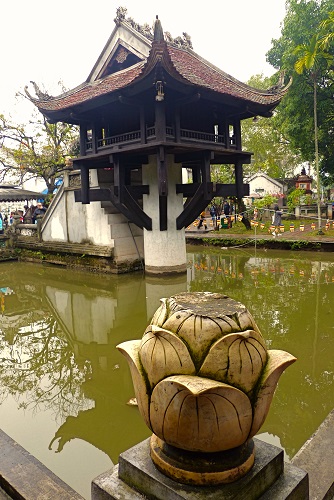We marched briskly, in neatly regimented rows, down the path and into the plaza. The bleak expanse of grey paving slabs perfectly matched the surrounding buildings and the steely sky above. We were led by a member of the military honour guard, dressed in a pristine white ceremonial uniform. He made a sharp left turn and we followed, parading to the front of Ho Chi Minh's Mausoleum. We stopped abruptly, without breaking ranks, and waited for our turn to enter.
The cuboidal granite tomb was largely devoid of decoration, save a few bare columns and President Ho Chi Minh's name inscribed above. As we waited outside, two guards goose-stepped past us carrying a large wreath of flowers. This was added to the row of wreaths already positioned in front of the mausoleum. Ceremony completed, we filed up the steps and in through the door.
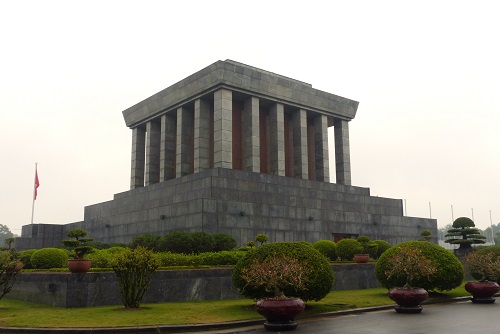
Ho Chi Minh's Mausoleum
President Ho Chi Minh asked to be cremated when he died. He hoped his body would then be buried in three separate locations, in north, central, and south Vietnam. Despite his wishes, his body has been put on display in Hanoi. Ho Chi Minh's Mausoleum was built on the site where, in 1945, he read the Declaration of Independence. He became the first president of the Democratic Republic of Vietnam, otherwise known as North Vietnam.
Inside Ho Chi Minh's Mausoleum
Inside the mausoleum, we followed the one-way system into the central chamber. The body of President Ho Chi Minh lay in a glass coffin in the middle of the dimly lit room. Having been embalmed, with additional maintenance work carried out annually, the body was perfectly preserved.
In single file, we made a slow lap around the coffin. With no explanation, one of the guards pulled me into a separate lane to walk around on my own. Perhaps I was walking too slowly. Even so, it was still a very brief visit. We were soon back outside, leaving the tightly restricted area around Ho Chi Minh's Mausoleum.

The Fish Pond
What Else Is There To See At Ho Chi Minh's Mausoleum?
Just a short walk from the mausoleum, we came to the Presidential Palace area. The palace itself was a grand, and very yellow, French colonial style building with an impressive staircase sweeping up to the front door. It was too ostentatious for President Ho Chi Minh so he never actually lived there. However, he did use it for entertaining guests. As the palace is still used for political meetings, we could only see it from a distance.
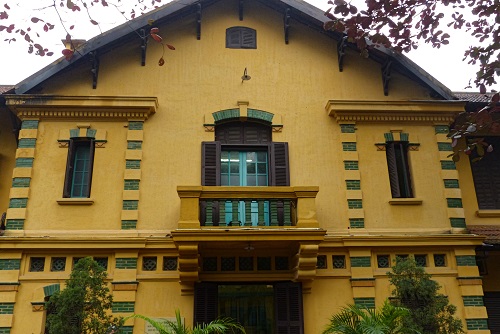
Politburo Meeting Room
Nearby, a collection of much smaller buildings housed the Politburo meeting room, a surprisingly humble house where the president lived for a few years, and his garage. The three cars in the garage were gifted to President Ho Chi Minh,with two of them coming from communist allies in Russia.
We walked past a large fish pond, bordered by Cypress trees with their knobbly 'knees' protruding phallically from the mud. This brought us to the stilt house, another very modest home used by the president in later life. We joined the line and filed along the walkway upstairs, stopping briefly to peer through each doorway on our way past. There were only two rooms: a bedroom and a study.
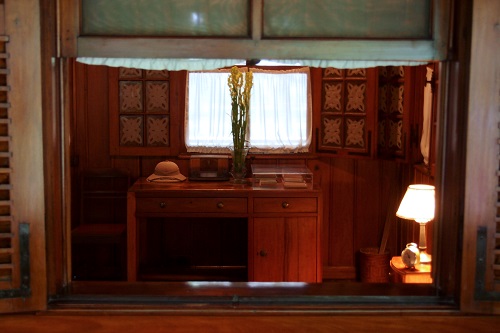
Inside The Stilt House
The One Pillar Pagoda
Our final stop was the One Pillar Pagoda, a tiny temple perched atop a stone pillar in the middle of a murky pond. The narrow steps were crowded and it took some time to get to the top. Once there, we briefly admired the interior, all too aware that we were blocking the way for the people behind us. The shrine was small but perfectly formed. A golden statue of the Goddess of Mercy took centre stage with lilies decorating the altar and piles of fruit stacked high in offering.
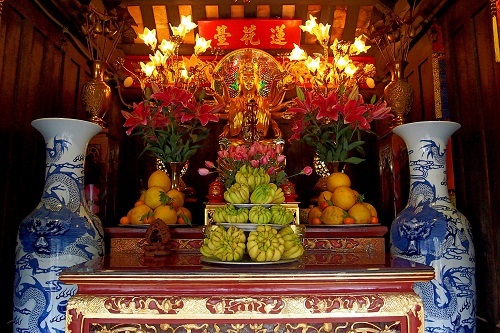
Inside The One Pillar Pagoda
Ho Chi Minh's Mausoleum Travel Tips
When visiting the mausoleum, dress modestly. Keep your arms and legs covered.
There is a cloakroom at the entrance to the complex. Deposit larger bags and backpacks here and collect them again when you leave.
There is a separate desk, near Ho Chi Minh's Mausoleum, where you will have to hand in your camera. It will be returned as soon as you leave the mausoleum so you can use it throughout the rest of your visit.
Ho Chi Minh's body is taken to Russia for maintenance work every year. This is usually throughout October and November. The mausoleum is closed during this time.
Ho Chi Minh's Mausoleum opens early and closes well before lunchtime. It is also closed on Mondays and Fridays. Check the opening times before you visit.
